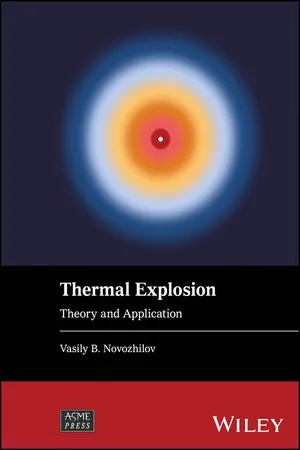
- English
- ePUB (mobile friendly)
- Available on iOS & Android
About this book
Thermal Explosion
A full review of thermal explosion theory featuring a new universal notation as a framework to develop and report research results
Summarizing all significant and notable developments made in the field over nearly 100 years, Thermal Explosion provides a single, authoritative source of information on the subject that connects the theory with examples from practical applications. After opening with an introduction to prerequisite technical information, the book goes on to cover the mathematical theory behind thermal explosion, with detailed explanations of how thermal explosion can develop in different media and under different conditions and strategies and techniques that can be used to prevent thermal explosion.
Readers will learn how to recognize thermal explosion hazards within technical designs and operation procedures, including for lithium ion batteries, biofuels, biomaterials, and microcombustors, predict the circumstances that may cause a thermal explosion in a particular design or process, and develop optimal mitigating strategies for these risks. Each chapter is supported by extensive example problems that introduce readers to a universal notation that can be used as a framework for developing and reporting their own research results.
Topics covered in Thermal Explosion include:
- Steady-state theory: the Semenov formulation and planar, cylindrical, and spherical symmetry cases in the Frank-Kamenetskii formulation
- Generalized boundary conditions, dynamical regimes, thermal explosion in a region of arbitrary shape, and nonsteady thermal explosion theory
- Thermal explosion in two-phase porous systems and spotted, diffusion, and conjugate thermal explosion
- One- and two-variable thermal explosion models of fire flashover
- Thermal explosion prevention through management of cooling flows and other passive methods, inertization, and cooling one- and two-phase media injections
Thermal Explosion is an essential, up-to-date reference on the subject for engineering researchers and professionals, along with mathematicians and other scientists working in related fields. The book is also an excellent learning aid within an academic setting for graduate-level researchers or as supplemental reading in upper-level courses.
Frequently asked questions
- Essential is ideal for learners and professionals who enjoy exploring a wide range of subjects. Access the Essential Library with 800,000+ trusted titles and best-sellers across business, personal growth, and the humanities. Includes unlimited reading time and Standard Read Aloud voice.
- Complete: Perfect for advanced learners and researchers needing full, unrestricted access. Unlock 1.4M+ books across hundreds of subjects, including academic and specialized titles. The Complete Plan also includes advanced features like Premium Read Aloud and Research Assistant.
Please note we cannot support devices running on iOS 13 and Android 7 or earlier. Learn more about using the app.
Information
Table of contents
- Cover
- Table of Contents
- Series Page
- Title Page
- Copyright Page
- Dedication Page
- About the Author
- Preface
- Important Notation and Abbreviations
- 1 Introduction
- 2 Classical Theory of Thermal Explosion
- 3 Extended Mathematical Theory of Thermal Explosion
- 4 Thermal Explosion in a Quiescent Medium
- 5 Thermal Explosion in Dynamic Mixtures
- 6 Thermal Explosion and Fire Dynamics
- 7 Thermal Explosion in Granular Reacting Media, Biosolid Fuels and Electric Batteries
- 8 Control Problem in the Theory of Thermal Explosion
- 9 Thermal Explosion Prevention
- References
- Problems
- Problem Solutions
- Index
- End User License Agreement